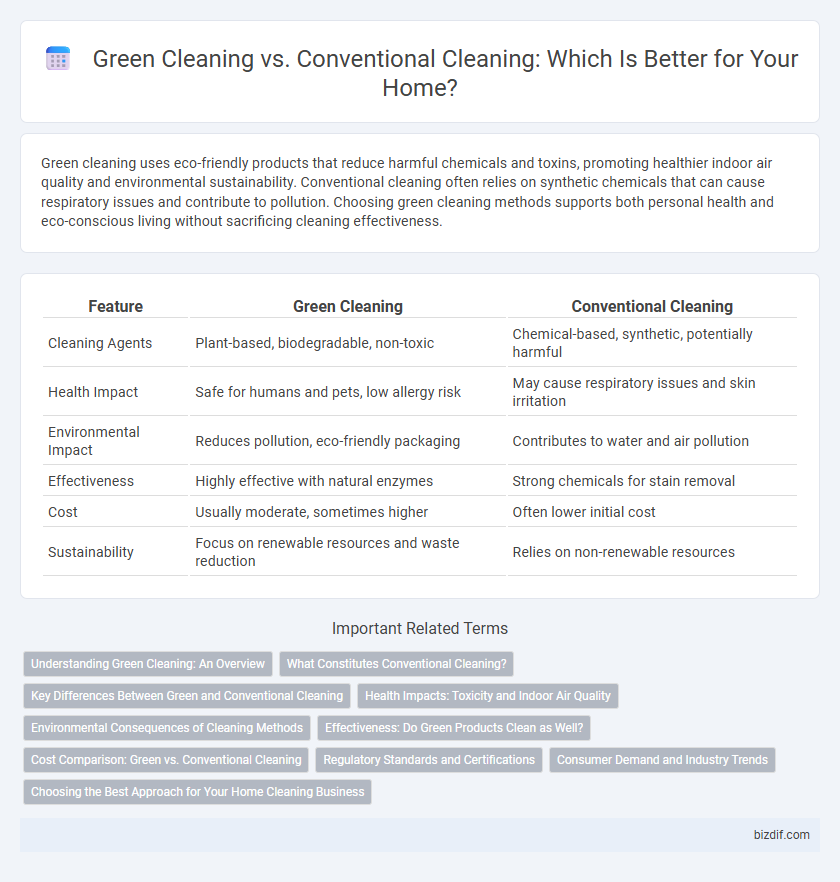Green cleaning uses eco-friendly products that reduce harmful chemicals and toxins, promoting healthier indoor air quality and environmental sustainability. Conventional cleaning often relies on synthetic chemicals that can cause respiratory issues and contribute to pollution. Choosing green cleaning methods supports both personal health and eco-conscious living without sacrificing cleaning effectiveness.
Table of Comparison
| Feature | Green Cleaning | Conventional Cleaning |
|---|---|---|
| Cleaning Agents | Plant-based, biodegradable, non-toxic | Chemical-based, synthetic, potentially harmful |
| Health Impact | Safe for humans and pets, low allergy risk | May cause respiratory issues and skin irritation |
| Environmental Impact | Reduces pollution, eco-friendly packaging | Contributes to water and air pollution |
| Effectiveness | Highly effective with natural enzymes | Strong chemicals for stain removal |
| Cost | Usually moderate, sometimes higher | Often lower initial cost |
| Sustainability | Focus on renewable resources and waste reduction | Relies on non-renewable resources |
Understanding Green Cleaning: An Overview
Green cleaning employs eco-friendly products free from harsh chemicals, reducing indoor air pollution and minimizing environmental impact. This method uses biodegradable ingredients and concentrates on sustainable practices, promoting healthier living spaces. Conventional cleaning often relies on synthetic chemicals that can cause respiratory issues and contribute to environmental toxicity.
What Constitutes Conventional Cleaning?
Conventional cleaning involves the use of chemical-based detergents, solvents, and disinfectants that often contain synthetic fragrances, dyes, and preservatives. These products can leave behind residues and contribute to indoor air pollution by releasing volatile organic compounds (VOCs). Many conventional cleaners are effective at removing dirt and germs but may pose health risks such as skin irritation or respiratory issues due to their harsh chemical ingredients.
Key Differences Between Green and Conventional Cleaning
Green cleaning uses environmentally friendly products with natural ingredients that reduce chemical exposure and indoor air pollution, promoting healthier living spaces. Conventional cleaning relies on synthetic chemicals and detergents that can leave harmful residues, contributing to environmental pollution and potential health risks. The key differences lie in ingredient composition, environmental impact, and safety for both humans and pets.
Health Impacts: Toxicity and Indoor Air Quality
Green cleaning uses non-toxic, plant-based ingredients that reduce exposure to harmful chemicals, improving indoor air quality and lowering health risks like respiratory issues and allergies. Conventional cleaning products often contain volatile organic compounds (VOCs) and synthetic chemicals that can contribute to indoor air pollution, irritate the respiratory system, and exacerbate asthma and other chronic conditions. Choosing green cleaning methods promotes a healthier home environment by minimizing toxic residues and enhancing overall air quality.
Environmental Consequences of Cleaning Methods
Green cleaning methods utilize biodegradable, non-toxic ingredients that minimize pollution and reduce hazardous waste, significantly lessening environmental impact compared to conventional cleaning products. Conventional cleaning products often contain harsh chemicals like ammonia, chlorine, and phthalates, which contribute to air and water pollution, posing risks to aquatic life and ecosystems. Choosing eco-friendly cleaning alternatives supports sustainability by lowering carbon footprints and preventing the accumulation of harmful substances in soil and waterways.
Effectiveness: Do Green Products Clean as Well?
Green cleaning products have advanced significantly, offering comparable effectiveness to conventional cleaners in removing dirt, stains, and germs while being non-toxic and eco-friendly. Many green formulas incorporate natural enzymes and plant-based surfactants that break down organic matter efficiently without harsh chemicals. Laboratory tests and user reviews consistently reveal that properly formulated green cleaners deliver thorough sanitation and surface care, challenging outdated views on their performance.
Cost Comparison: Green vs. Conventional Cleaning
Green cleaning products typically have a higher upfront cost compared to conventional cleaning supplies, but they often require smaller quantities due to concentrated formulas, leading to long-term savings. Conventional cleaning materials may be cheaper initially but can incur additional expenses from potential health issues and environmental damage. Over time, green cleaning proves more cost-effective by reducing risks and promoting sustainability in household maintenance.
Regulatory Standards and Certifications
Green cleaning products comply with strict regulatory standards such as EPA's Safer Choice and Green Seal certifications, ensuring they contain fewer harmful chemicals and reduce environmental impact. Conventional cleaning products may not always meet these rigorous criteria, often containing synthetic chemicals that can pose health risks and contribute to indoor air pollution. Choosing green cleaning solutions supports adherence to health and safety regulations while promoting sustainable household maintenance.
Consumer Demand and Industry Trends
Consumer demand for green cleaning products has surged, driven by increased awareness of environmental impact and health benefits such as reduced exposure to harsh chemicals. Industry trends reveal that manufacturers are prioritizing biodegradable ingredients and eco-friendly packaging to meet regulatory standards and appeal to environmentally conscious buyers. Conventional cleaning methods still dominate in cost-sensitive markets but face declining demand as sustainability becomes a key purchasing factor.
Choosing the Best Approach for Your Home Cleaning Business
Green cleaning employs eco-friendly products and sustainable practices to reduce environmental impact while promoting healthier indoor air quality. Conventional cleaning often relies on chemical-based solutions that may provide strong disinfection but can pose health risks and contribute to pollution. Evaluating customer preferences, cost-effectiveness, and regulatory compliance helps determine whether green cleaning or conventional methods best align with a home cleaning business's goals.
Green Cleaning vs Conventional Cleaning Infographic

 bizdif.com
bizdif.com